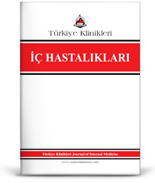Hiponatremi, klinik pratikte en sık görülen sıvı elektrolit bozukluğudur. Hastanede yatış süresini artırmakta ve hastalıkların seyri sırasında mortalite için bağımsız bir risk faktörü olarak kabul edilmektedir. Serum sodyum konsantrasyonunun 135 mEq/L'nin altında olması, hiponatremi olarak tanımlanır. Hiponatremiler, serum ozmolalitesine göre 3'e ayrılır. Gerçek hiponatremi, serum ozmolalitesinin 275 mOsm/kg H2O'dan düşük olduğu hipotonik hiponatremilerdir. Normal serum ozmolaliteli ya da 295 mOsm/kg H2O'dan yüksek serum ozmolaliteli hiponatremiler de olabilir ve bunlar gerçek olmayan yani nonhipotonik hiponatremilerdir. Nonhipotonik hiponatremiler, beyin ödemine yol açmazken, hipotonik hiponatremiler beyin ödemine yol açabilirler. Hipotonik hiponatremide klinik bulgulara neden olan asıl faktör, serum ozmolalitesindeki azalma ve buna bağlı gelişen beyin ödemidir. Beyin ödemi ve hayatı tehdit eden klinik bulguların gelişmesini belirleyen temel faktörler, hiponatreminin gelişme süresi ve derinliğidir. Beynin hipotonik ortama uyum sağlaması için gereken minimum süre 48 saattir. Kırk sekiz saatten kısa sürede gelişen hiponatremiler akut, 48 saatten uzun sürede gelişenler ise kronik hiponatremi olarak tanımlanmaktadır. Baş ağrısı ve bulantı, beyin ödeminin uyarıcı işaretleridir. Klinik tablo ilerledikçe kusma, nöbet ve sonunda beyin sapı herniasyonu ve solunum durması gelişecektir. Kronik hiponatremilerde ise beyin hücreleri adaptasyon için yeterli zamana sahiptir ve beyin ödemi riski azalır. Baş ağrısı, bulantı ve konfüzyon orta-ciddi semptomlar olarak değerlendirilirken; kusma, somnolans, nöbet, kardiyopulmoner sıkıntı ve koma ciddi semptomlar olarak değerlendirilmelidir. Ciddi semptomların mortalitesi yüksektir ve daha agresif tedavi gerektirmektedir. Bu derlemede, hiponatremi gelişiminde rol oynayan etiyolojik faktörler, tanı ve tedavi yaklaşımları güncel kılavuzlar ışığında özetlenecektir.
Anahtar Kelimeler: Sodyum; hiponatremi; beyin ödemi; ozmotik demiyelinizasyon sendromu
Hyponatremia is the most common fluid electrolyte disorder in clinical practice. It prolongs hospital stay and it is considered as an independent risk factor for mortality. A serum sodium concentration below 135 mEq/L is defined as hyponatremia. There is an excess of water compared to sodium and can be dilutional or depletional. Hyponatremia can be divided into 3 groups according to serum osmolality. True hyponatremia is hypotonic hyponatremia in which serum osmolality is below 275 mOsm/kg H2O. Hyponatremias with normal serum osmolality or serum osmolality higher than 295 mOsm/kg H2O are called as non-hypotonic hyponatremias. Non-hypotonic hyponatremias do not cause brain edema, whereas hypotonic hyponatraemia can cause. The depth of hyponatremia and time to occurrence of hyponatremia are the factors that determine brain edema and life threatening clinical findings. Hyponatremia that develops in less than 48 hours is defined as acute and more than 48 hours is defined as chronic. Headache and nauseas are the warning signs of brain edema. As this clinical condition progresses, vomiting, convulsions, brainstem herniation and respiratory arrest will develop. In chronic hyponatremia, the brain cells gain enough time for adaptation and reduces the risk of brain edema. Headache, nausea and confusion are moderate to severe symptoms and vomiting, somnolence, cardiopulmonary distress should be considered as severe symptoms. Serious symptoms have higher mortality and require more aggressive treatment. In this review, etiological factors, diagnosis and treatment approaches of hyponatremia will be summarized in the light of current guidelines.
Keywords: Sodium; hyponatremia; brain edema; osmotic demyelination syndrome
- Upadhyay A, Jaber BL, Madias NE. Epidemiology of hyponatremia. Semin Nephrol. 2009;29(3):227-38. [Crossref] [PubMed]
- Oster JR, Singer I. Hyponatremia, hyposmolality, and hypotonicity: tables and fables. Arch Intern Med. 1999;159(4):333-6. [Crossref] [PubMed]
- Spasovski G, Vanholder R, Allolio B, Annane D, Ball S, Bichet D, et al; Hyponatraemia Guideline Development Group. Clinical practice guideline on diagnosis and treatment of hyponatraemia. Nephrol Dial Transplant. 2014;29 Suppl 2:i1-i39. Erratum in: Nephrol Dial Transplant. 2014;40(6):924. [Crossref] [PubMed]
- Hillier TA, Abbott RD, Barrett EJ. Hyponatremia: evaluating the correction factor for hyperglycemia. Am J Med. 1999;106(4):399-403. [Crossref] [PubMed]
- Schwartz WB, Bennett W, Curelop S, Bartter FC. A syndrome of renal sodium loss and hyponatremia probably resulting from inappropriate secretion of antidiuretic hormone. Am J Med. 1957;23(4):529-42. [Crossref] [PubMed]
- Powel JE, Rosenthal E, Roman A, Chasen ST, Berghella V. Preeclampsia and low sodium (PALS): a case and systematic review. Eur J Obstet Gynecol Reprod Biol. 2020;249:14-20. [Crossref] [PubMed]
- Cantini L, Merloni F, Rinaldi S, Lenci E, Marcantognini G, Meletani T, et al. Electrolyte disorders in advanced non-small cell lung cancer patients treated with immune check-point inhibitors: a systematic review and meta-analysis. Crit Rev Oncol Hematol. 2020;151:102974. [Crossref] [PubMed]
- Frizzell RT, Lang GH, Lowance DC, Lathan SR. Hyponatremia and ultramarathon running. JAMA. 1986;255(6):772-4. [Crossref] [PubMed]
- Hew-Butler T, Loi V, Pani A, Rosner MH. Exercise-associated hyponatremia: 2017 update. Front Med (Lausanne). 2017;4:21. [Crossref] [PubMed] [PMC]
- Adrogué HJ, Madias NE. Hyponatremia. N Engl J Med. 2000;342(21):1581-9. [Crossref] [PubMed]
- Verbalis JG, Goldsmith SR, Greenberg A, Schrier RW, Sterns RH, Thompson CJ. Diagnosis, evaluation, and treatment of hyponatremia: expert panel recommendations. The American Journal of Medicine 2013;126(10):S1-S42. [Crossref] [PubMed]
- Jaber BL, Almarzouqi L, Borgi L, Seabra VF, Balk EM, Madias NE. Short-term efficacy and safety of vasopressin receptor antagonists for treatment of hyponatremia. Am J Med. 2011;124(10):977.e1-9. [Crossref] [PubMed] [PMC]
- Ghali JK, Koren MJ, Taylor JR, Brooks-Asplund E, Fan K, Long WA, et al. Efficacy and safety of oral conivaptan: a V1A/V2 vasopressin receptor antagonist, assessed in a randomized, placebo-controlled trial in patients with euvolemic or hypervolemic hyponatremia. J Clin Endocrinol Metab. 2006;91(6):2145-52. [Crossref] [PubMed]
- Torres VE, Chapman AB, Devuyst O, Gansevoort RT, Grantham JJ, Higashihara E, et al; TEMPO 3:4 Trial Investigators. Tolvaptan in patients with autosomal dominant polycystic kidney disease. N Engl J Med. 2012;367(25):2407-18. [Crossref] [PubMed] [PMC]
- U.S. Food & Drug Administation [İnternet]. FDA Drug Safety Communication: FDA limits duration and usage of Samsca (tolvaptan) due to possible liver injury leading to organ transplant or death. 2013. Erişim linki: (Erişim tarihi: 30.04.2013) [Link]
- Zhou Y, Yang W, Liu G, Gao W. Risks of vaptans in hypernatremia and serum sodium overcorrection: a systematic review and meta-analysis of randomised controlled trials. Int J Clin Pract. 2020;17:e13939. [Crossref] [PubMed]
- Hoorn EJ, Zietse R. Diagnosis and Treatment of hyponatremia: compilation of the guidelines. J Am Soc Nephrol. 2017;28(5):1340-9. [Crossref] [PubMed] [PMC]







.: Process List